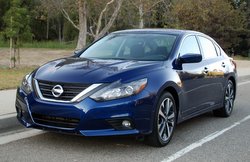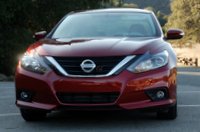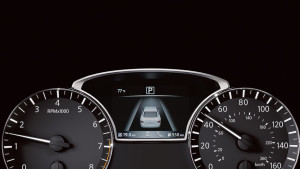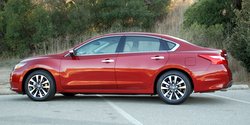Nissan’s Biggest Seller Gets Frisky
Story by John Faulkner and Michael Coates
The midsize sedan market used to be the hot spot in the car market, only to be eclipsed by compact SUV/CUVs. It’s still on about two million persons shopping lists, led by names like Toyota Camry and Honda Accord. Close on the heels of those two perennials is the Nissan Altima, which is Nissan’s best-selling vehicle.
It was due for a refresh and upgrade to keep up with the competition (or as the automotive industry calls it, a mid-cycle makeover), so the designers took extreme care not to mess too much with an already good thing. What did they come up with for the 2016 Altima? How about a car that offers sleek styling, class-leading (non-hybrid) fuel economy, luxury class-like quietness, a beefier suspension, a smooth engine and slick-shifting (more on that later) transmission all wrapped into a five-passenger sedan.

Driving Experience: On the Road
The front-wheel drive 2016 Nissan Altima is powered by either a 2.5-liter, DOHC, 16-valve, four-cylinder engine producing 182 hp or a 3.5-liter V6 that produces 270 hp. Both engines are mated to a continuously variable transmission (CVT), which with a few other tricks has helped Nissan to push highway fuel economy in the Altima to 39 mpg (with the four-cylinder engine). Clean Fleet Report had the opportunity to spend the day with the SR and SL versions of the 2016 Altima 2.5L at a Nissan press event, where we drove each car through Malibu along Pacific Coast Highway and then snaked into the Santa Monica Mountains.

We gave high marks in our earlier review of the 2014 Altima for its handling, acceleration and fuel economy, which we put in our “Almost 40 MPG Club” as it was EPA rated at 38 mpg on the highway. Well, Nissan has nudged the Altima even closer to that magic number by increasing the highway mileage to 39 mpg which is best-in-class on the highway in the midsize segment. This may not seem like a big improvement, but keep in mind that this is a 3,250-lb., five-passenger sedan where squeezing out an extra mpg is commendable (especially while holding horsepower and maybe even adding a few pounds). Nissan achieved the increase by reducing the coefficient of drag to .26 CD from .29 CD through their “Energetic Flow” design language that is also seen on the 2016 Murano SUV and 2016 Maxima. The one mile per gallon increase came through the addition of active grille shutters, changes to the engine compression ratio and reduced engine friction for a 10-percent improvement in overall aerodynamics.
Clean Fleet Report will have a more extensive Road Test Review of the 2016 Altima, but our initial impressions between the two tested cars were the handling upgrades for the sportier Altima SR made it better for feeling road input while the SL version had a more traditional ride found in cars in the midsize segment, but still better than some of the competition. The SR benefited from better handling characteristics through 18-inch wheels and unique tires versus 17-inch wheels for the SL, ZF Sachs shock absorbers, larger stabilizer bars and a change in the front and rear damping force that has reduced body roll by more than 20-percent compared to the SL model.
Driving Experience: Exterior and Interior
The front and rear clips of the Nissan Altima are redesigned for the 2016 model year, with a new V-motion grille, “boomerang” headlights, daytime running lights and taillights and a reshaped hood, front and rear fenders, fascias and stylish sculpted front and rear bumpers along with a reshaped rear deck lid.
The Altima interior continues to try to balance a conservative, non-flashy approach with a techie upscale look and feel, using soft materials and surfaces presented with an attention to detail. New

for 2016 is the information-centric center stack area with a horizontal console and a design theme of the “Gliding Wing” that runs from door-to-door across the dash. It all fits and works very nicely.
Nissan has spent some time on noise-reduction, looking to add that “luxury” touch to its mainstream sedan. New acoustic glass and denser sound-deadening material do the job and have created a quiet interior, unless the buzzing sound of the four-cylinder engine straining under hard acceleration intrudes.
Nissan’s front driver and passenger “zero gravity seats” – that were designed using seating and posture research conducted by NASA – stay with the 2016 Altima and are available in cloth in the SR and leather in the SL. The rear bench seat, that splits 60/40, accommodates three adults. For longer trips or commutes, two adults would be a better arrangement to guarantee a comfortable ride and take advantage of the fold down center armrest, 12V power outlet, rear heating and cooling vents and multiple cup holders.

The infotainment system has a near endless list of features that are almost becoming expected on a well-equipped car, with the showcase being their NissanConnect with Mobile Apps system. Offering a wide choice of convenience features that include being able to, with the punch of a button and a voice command, connect driver and passenger to a live operator for directions and other assistance; think of it as Nissan’s version of GM’s Onstar. One short-fall is the lack of Apple Car Play or Android Auto, something the midsize competitors have jumped on quickly. Nissan says “they’re coming.”
Safety and Convenience
The 2016 Altima shows the continuing down-market movement of advanced safety technologies, the building blocks of the autonomous car that Nissan boss Carlos Ghosn says is coming in 2020. The Altima has an extensive list of safety and convenience features, which Nissan calls its “Safety Shield” technologies, that have been joined in 2016 by predictive forward collision warning (PFCW), which they claim is a segment exclusive, which will warn the driver of risks not only from the car in front of you, but two cars ahead. The PFCW is joining with forward emergency braking (FEB), which will apply the brakes to avoid or mitigate a collision; intelligent cruise control (ICC), which also can stop a vehicle in traffic; and rear cross traffic alert (RCTA), an assistant for blind spots while backing.
Pricing and Warranties
Base pricing for the seven 2016 Nissan Altima models:
2.5 $22,500
2.5 S $22,900
2.5 SR $24,470

2.5 SV $25,460
2.5 SL $28,570
3.5 SR $27,390
3.5 SL $32,090
All prices are MSRP and do not include the $825 Destination and Handling Charge.
The 2016 Nissan Altima comes with these warranties:
- Basic – Three-year/36,000-mile
- Powertrain – Five-year/60,000-mile
- Corrosion – Five-year/Unlimited-mileage
Observations: 2016 Nissan Altima 2.5 SR and 2.5 SL
With Altima representing one-fourth of their sales, Nissan has a lot riding on keeping the 2016 Altima ahead of its competitors in a very crowded segment of solid midsize sedans. Our initial take in this First Drive is that the 2016 Altima is much improved over the 2015 version, in many ways that will be noticeable to current owners and those driving Nissan’s automotive competitors.

We suggest driving the SR version on some twisty roads just to get the sense for what Nissan has accomplished in taking the Altima closer to being a true driver’s car. One thing they added as an accommodation to enthusiast drivers is shift points. That might make sense until you realize the car’s transmission is a CVT that does not have shift points. The artificial “shifts” were added for a more traditional feel to acceleration. For what it’s worth, it bothers me less than adding paddle shifters to a transmission that has no gears to shift. Left to its own devices, the CVT works well and rarely do you feel the lack of “gears.” The better fuel economy is the benefit of all this advanced technology. Almost 40 mpg fuel economy, solid styling and road-gripping handling in an almost entry-level-priced midsize sedan means Nissan has thrown down a gauntlet that says it is after more of this big market segment.
Whatever you buy, Happy Driving!
Related Stories You Might Enjoy:
Road Test: 2015 Honda Accord Hybrid
Road Test: 2014 Toyota Camry Hybrid
Road Test: 2014 Nissan Altima
Road Test: 2015 Mazda6
Disclosure:
Clean Fleet Report is loaned free test vehicles from automakers to evaluate, typically for a week at a time. Our road tests are based on this one-week drive of a new vehicle, which does not address issues such as long-term reliability or total cost of ownership. In addition we are often invited to manufacturer events highlighting new vehicles or technology, during which we may be offered free transportation, lodging or meals. We do our best to present our unvarnished evaluations of vehicles and news irrespective of these inducements. Our focus is on vehicles that offer the best fuel economy in their class or are among the top mpg vehicles on the market. In addition, we aim to offer reviews and news on advanced technology and the alternative fuel vehicle market. We welcome any feedback from vehicle owners and are dedicated to providing a forum for alternative viewpoints. Please let us know your views at publisher@cleanfleetreport.com.

Great article about [2016] Nissan Altima. awesome look of this car . thanks for sharing this blog with us .
@Honda Elysion,
Great driving, too. We definitely think the 2016 Nissan Altima should be moving up on folks’ shopping lists. –ed.